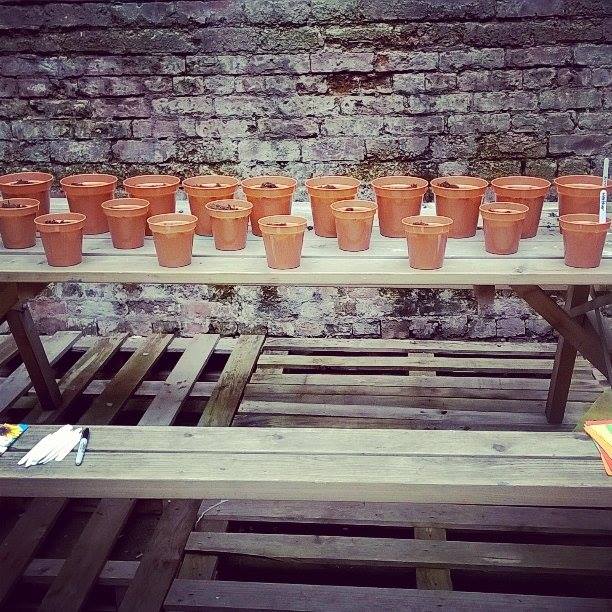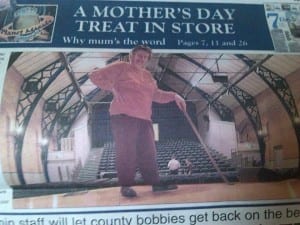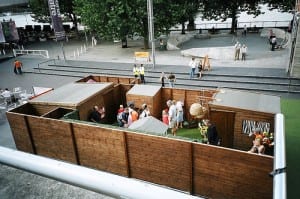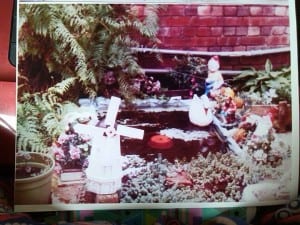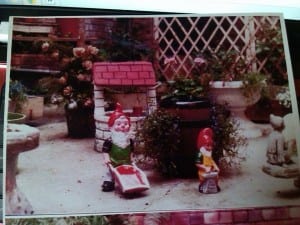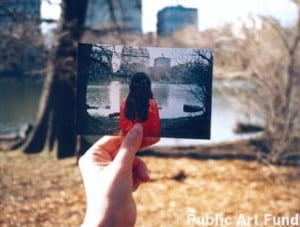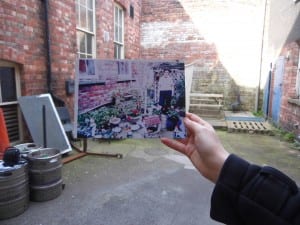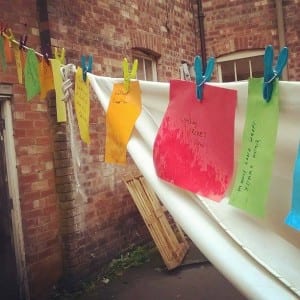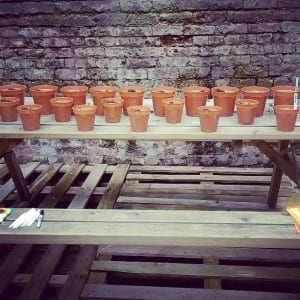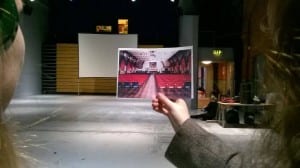Framing Statement
Taking Care was a site specific interactive audio tour that was performed at The Lincoln Drill Hall on the 8th May 2015. It consisted of eighteen 10 minute slot performances to one audience member at a time between 2pm and 5pm. The performance was a memorial piece, commemorating the lives of Betty and Albert, the previous caretakers at The Lincoln Drill Hall. Our performance was inspired by various site specific practitioners, such as Janet Cardiff and Raisin and Willow. All of the script for the audio was pulled directly from quotes from the family we met and spoke to and from the newspaper article we received.
The performance took place throughout the building, starting in the box office, then going into the auditorium and then going back around through to the courtyard, as this is where we had photos for. The audience signed up for a 10 minute slot in the site specific box office that had been set up for sign-up sheets, and then they were greeted by Heather and I at the beginning of their 10 minute slot by the box office. With the sign-up sheet we had placed a newspaper article we had received about when Betty re-opened the Drill Hall, therefore inviting the audience to read it if they wanted to, to give the audience some insight into what the performance was about.
The audience were involved by listening to our audio and also by agreeing to being lead around. The performance became completely about them hearing and seeing the memories of Betty and Albert and their family, and at the end they joined us in commemorating their lives by planting a seed, writing a memory of theirs of the Drill Hall and pegging it to the washing line and being offered a sherbet lemon – one of the Huckett’s favourite sweets.
Our aim when creating the piece was to commemorate Betty and Albert’s lives with people who may or may not have known them by sharing memories and experiences of theirs with them with a visual and audio experience. The interesting thing about our main aim is that for some people it gave them a performance that taught them new things about people they did not know in the Drill Hall. Whereas for some other audience members it became a reminiscent piece.
Analysis of Process
On our first day of having site specific lessons at the Lincoln Drill Hall, we were given a tour of the building with a few facts about the history of the place. This was when my interest in Betty and Albert’s story was sparked, as we were told about how they used to be the caretakers of the building and how they used to live in the building next to the courtyard, which is now a neglected storage space.
After my interest in Betty and Albert’s life was sparked during our tour of the Lincoln Drill Hall, I was certain I wanted to do something that would commemorate their lives within the Lincoln Drill Hall. I think the reason I was interested in Betty and Albert was because they were such an important part of the building, so important in fact, that Betty actually opened the building in 2004 when it re-opened as a theatre. I was excited to find out more about these two caretakers, and what made them so important to the building.
Heather and I decided to work as a group as we both liked the idea of using the courtyard and finding more out about Betty and Albert to create a performance on. Our initial idea was based on Metro Boulot Dodo’s Spring and Raisin and Willow’s Making Time. We planned on using only the courtyard and re-creating the space as it used to be by planting flowers and gathering other garden things such as gnomes and bird houses.
Making Time by Raisin and Willow was one of our inspirations, as they created a beautiful space from a mundane area. Their idea was “to explore ideas of time and endurance; performance and presence, within the framework of one year.” (Raisin and Willow, 2015) So they decided to create a garden in the heart of Lancaster university campus over the space of a year.
Four Seasons: Spring by Metro Boulot Dodo was also one of our inspirations because they created a garden… “Beyond an 8-foot fence lies Polly’s garden, an absurd and garish place where everything is filtered through one girl’s erratic and infectious imagination.” (Metro Boulot Dodo, 2005) It was an interactive garden, showing the world through an 8 year olds eyes. As you can see in the image below, it was also built in a space that would not normally be deemed ‘suitable’ for a garden.
We took inspiration from these because we also wanted to create an amazing garden that people could interact with and that could become more of a community area. Like both of these pieces, we intended on taking a place that would not normally be seen as a garden, and turning it into a wonderful garden like the Huckett’s used to have.
After this we found contact with some of their relatives via Facebook (rather unprofessionally, but still smartly) and after that we organised a meeting with their grandson who put us in contact with his parents, and Heather also met another one of their grandsons. Upon meeting them Heather spoke with them about Betty and Albert and learnt some things about them which we included in our piece, such as the love for sherbet lemons and chopped Brazil nuts the couple had. She also received some photographs of Betty and Albert when they lived in the Drill Hall and a newspaper article from when Betty re-opened the Drill Hall, and also a writing from one of their children of their memories.
After seeing these photos and toying with the idea of trying to recreate this brilliant garden we were shown, we realised it would not be a possibility for us to do it, with the time and money we had. We did not want our attempt of a significant garden to end up being a lot of plastic plant pots with yet-to-grow seeds in them. This was when we considered perhaps making the garden larger than life and using huge fake flowers to make it seem too big and too bright, as to juxtapose the current state the courtyard was in, while still making it a nice place to be. But we wanted to incorporate the pictures we had received so planned of having a projection of them going on throughout the installation performance.
The next week was the week I discovered Janet Cardiff’s piece, Her Long Black Hair – which is an audio visual tour around Central Park in New York. This was the beginning to finding our final idea, as it gave the idea of creating an audio tour using the pictures in a similar way that she does in it, a she instructs an audience member to hold up certain photos in certain places that correlate to show the past and present at the same time. We wanted to connect the past and present in a similar way, by showing them photos of the place they are at and telling them memories of the place while they are still, obviously in the present.
“Walking is very calming. One step after another, one foot moving into the future and one in the past. Did you ever think about that? Our bodies are caught in the middle. The hard part is staying in the present. Really being here.” (Cardiff, 2005) This was part of Cardiff’s audio tour that I really liked and really wanted to use, the thought that we are constantly in the past and the future, while struggling to be in the present.
“On the one hand artworks define their own unique space, and on the other they are designed to tackle the accusations of irrelevance levelled at them by new modes of social and philosophical thought – indeed, since the 1960s, artworks have often developed into (close approximations of) social and philosophical thought. Which is why walking, as an activity that is usually invisible but that can become visible, that is usually unremarked but that can become fully choreographed, that is usually useful but that can become useless, and that always dallies between conscious and unconscious decision-making, is attractive.”(Phillips, 2005, 509) Walking is a normal day-to-day task, but in our performance, we made it choreographed, the audience were to walk to where we wanted them to walk, when we wanted them to walk. In a way this made the performance not only a performance for the audience member with the headphones, but for any passing spectators who might have seen us performing it.
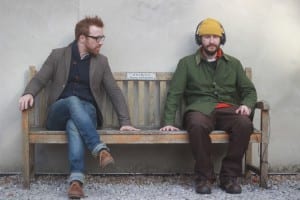
Image of Sit With Me For A Moment and Remember from http://michaelpinchbeck.co.uk/sit-with-me-for-a-moment/
Michael Pinchbeck’s Sit With Me For a Moment and Remember was also part of our inspiration – the use of audio to draw attention to and to reminisce about a particular place. “Site-specific can be especially powerful as a vehicle for remembering and forming a community for at least two reasons. First its location can work as a potent mnemonic trigger, helping to evoke specific past times related to the place and time of performance and facilitating a negotiation between the meanings of those times.” (Harvie in Pearson, 2010, 9)The audience interaction used in this piece is also something we picked up on, it was simple, but effective. We used this in our piece as we guided the audience around, and moved and showed photos to them at certain points.
Initially we were only going to use the courtyard, but then we decided it would be more effective if we used more of the building along with more of the quotes from the families memories, so it expanded to use the box office, the plaque, the auditorium, outside the cellar, and finally the courtyard, as the courtyard was still our main focus point. The final piece was created completely by quotes directly from the family and from Betty herself in a newspaper article from 2004. We also used genuine photos from when Betty and Albert lived in The Drill Hall were used in the performance to connect the past with the present, like in Her Long Black Hair.
After creating the bulk of our main performance, we decided we wanted to create a ‘post performance’ phase, where the audience would plant a seed and write a memory of this of being at the Drill Hall. The reason we decided to do this was to create a future for the performance, the performance will not happen and then just be forgotten, as the flowers will hopefully grow, creating a memory of the performance, and a memory of Betty and Albert. Getting the audience to write a memory of theirs made us reminisce together for different reasons.
As we got closer to the performance we started making audio recordings of our script to test them in the Drill Hall, we would test them on each other and then either Michael or a fellow classmate. We would ask for feedback on how they felt it was and then go back and edit the audio to make it better. Overall by the final performance we made approximately 5 editions of the audio. The audio we used for the performance was written by Heather and I, but it was purely created using quotes from the memories given to us. It was recorded by me and edited by Simon Payne with the assistance of Heather and I. Simon spoke as ‘Steve’ one of the grandchildren, Heather spoke as ‘Mary’ one of the children and I spoke as Betty herself. Initially we thought finding voices to represent these people would be a difficulty as we wanted it to be as true to the real thing as we could possibly make it. Then we realised it is not who speaks it that is important, it is what they are saying.
When we first made the audio, we planned on starting in the back area, near the old front door, but then we decided to move it to the box office when we changed around the order of the audio and decided it made more sense to do this as then we could collect people and ‘take care’ of them better if we met them in the reception. It also meant we would not interrupt some of the other performance that were happening in the back of the Drill Hall.
The last additions we made to the performance was adding music to the background of certain bits of the audio to make it more lively and connecting for the audience. Such as adding Christmas music to the background of the section about how they used to spend Boxing Day, and the theme tune to Coronation Street when they mentioned they used to watch it with the performers that used to come the Drill Hall.
For our final rehearsal, Heather and I took each other around and worked out the timings of when we move and hold up the photos. This was when we discovered it worked best if both of us go around together, one to hold the photos and guide the audience member and the other to watch the time and prompt us to move to the next location.
Performance Evaluation
Doing site specific performance has made me realise that performance can happen anywhere – although we were in a performance venue, we were not using it how it is normally used, and we were using unconventional spaces that would not normally be used for performance.
The final performance was an interactive audio tour that lasted approximately 7 minutes per person. Heather and I greeted our audience member at the box office and explained that they were to wear the headphones and be guided by either me or Heather and to stop where our taped crosses indicated to stop. We then guided the audience from the box office, to the plaque, to the auditorium, to outside the cellar and then, finally into the courtyard while they listened to the story of Betty and Albert through the headphones, and were occasionally shown photos to match their current location. At the end of the performance the audience were invited to plant a seed and to write a memory of theirs of the Drill Hall and peg it to the washing line. They were then offered hand sanitizer and a sherbet lemon before we took them back into the box office.
Out of the possible 18 audience members we could have had, we had a total of 15 (although on the sign-up sheet it shows 16 slots being taken as we expected another member of the Huckett family to come). I felt this was a great success, as I initially worried we would not have very many people.
I felt one of the strengths of our performance was that it was a one to one experience (although technically speaking, a two to one). But although we both went around with the audience member, it still felt one to one, as there was only one leading. “One to One performances feel personal, and if we commit ourselves to them, they can affect us in a myriad of ways.” (Zerihan, 2009, 3-4) I feel we achieved to make it feel personal for each audience member, each person will have felt different about the audio they heard, some reminiscent, some enlightened, and some perhaps inquisitive to know more.
One of the main weaknesses of our performance was something as simple as walking through doors, it was difficult as there was a lack of space due to other audience members and other performances. This could have been overcome if we had communicated with other groups better, and if there was not 3 of us all walking around it together. Another weakness of ours was that when we began our performance at the beginning of the day, we held people’s hands to guide them around, but as it became obvious that this was making people feel uncomfortable, we decided to change strategy by guiding them by the arm. This is something we had considered before our performance, but having tested it beforehand, people were fine with holding hands, I suppose it depends on the person and the relationship you have with that person.
If I were to do this performance again, three things I would do to improve it would be: Finding better, more suitable costumes. Although our brown jackets worked fine, I do not really feel they really represented us as caretakers, which was our intention, as we took care of the audience. Also offering the audience whether they would rather be guided by the hand, the arm, the shoulder or not at all, as to make it as comfortable for them as possible. And lastly I would have organised going outside better – because it was raining we had to juggle around what we were doing so we could get the umbrella for the audience member, although this was a nice touch, it looked and felt a bit messy.
Overall the end performance seemed to be received well by everybody who experienced it. A couple of the Drill Hall staff members came to see it and told us how they found it interesting as it was a mix of new pieces of information and also things they already knew. We also had the privilege of one of Betty and Albert’s sons coming to experience our performance. He seemed to enjoy it and after it had finished he continued to reminisce and tell us about the layout of the house, which room was which – which was also interesting for us as we could not really learn a lot about the house as it was out of bounds.
I believe we achieved our aim to commemorate Betty and Albert’s lives as we shared their story with new people, and helped people who already knew their story reminisce. The story continued after the performance as The Drill Hall chose to keep the seeds we had planted, so hopefully they will grow and create a beautiful space once again in memory of Betty and Albert.
Word Count: 3048
Bibliography
Cardiff, J. (2005) Her Long Black Hair. New York: Central Park, June 16 – Sept 11. Available from http://phiffer.org/hlbh/#digitalarchive [Accessed 14 May 2015].
Cuttlefish. (2005) Metro Boulot Dodo: Four Seasons: Spring. [online] Metro Boulot Dodo. Available from http://www.metro-boulot-dodo.com/spring.html [Accessed on 15 May 2015]
Pearson, M (2010) Site Specific Theatre. Hampshire: Palgrave Macmillan
Phillips, A. (2005) Walking and Looking. Cultural Geographies In Practice, 12: 507–513.
Raisin and Willow. (2015) Raisin and Willow: Making Time. [online] Raisin and Willow. Available from http://raisinandwillow.co.uk/projects/making-time/ [Accessed on 15 May 2015].
Zerihan, R.(2009) Live Art Development Agency Study Room Guide On One to One Performance.
